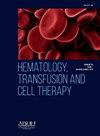ACUTE LYMPHOBLASTIC LEUKEMIA DIAGNOSED FOUR YEARS AFTER HSCT IN A BETA THALASSEMIA PATIENT: A CLINICAL CASE
IF 1.6
Q3 HEMATOLOGY
引用次数: 0
Abstract
Introduction
Beta thalassemia is an inherited blood disorder caused by defective synthesis of the beta chains of hemoglobin. This results in the production of ineffective red blood cells, leading to anemia and a severe reduction in the ability to transport oxygen to organs and tissues. In some cases, patients with beta thalassemia, due to prolonged treatment processes and other factors, may develop malignant hematologic disorders. This case presentation describes a patient diagnosed with beta thalassemia major who developed Acute Lymphoblastic Leukemia (ALL) four years after undergoing Hematopoietic Stem Cell Transplantation (HSCT).
Materials and methods
A patient diagnosed with beta thalassemia major, registered at the Thalassemia Center (TC), underwent allogeneic HSCT in 2020 and was later diagnosed with T-cell Acute Lymphocytic Leukemia (T-ALL) four years post-transplant.
Results
A 19-year-old male patient was diagnosed with beta thalassemia major at the age of one year. He has been under regular follow-up at the Thalassemia Center since the age of six. At seven years old, he was officially diagnosed with “Beta Thalassemia Major” (HbA2 ‒ 3.9%; HbF ‒ 57.1%) and has since been on a transfusion regimen with chelation therapy. On February 23, 2020, he underwent an allogeneic bone marrow transplantation from his HLA 10/10 matched sibling using the BU/Flu/CY/ATG/TT myeloablative conditioning regimen. Post-transplant chimerism analysis showed 93% donor cells. The patient was regularly monitored at the TC-HSCT outpatient clinic.
Medical history
The patient was born from his mother’s third pregnancy and third delivery.
• Two siblings from previous pregnancies did not survive.
• He was born at term with a birth weight of 3500g.
• He had incomplete routine vaccinations.
• He had a history of measles and chickenpox infections.
• The family denies a history of tuberculosis or venereal skin diseases.
• One healthy sibling lives at home.
• Parents are not consanguineous.
• The father was diagnosed with Hodgkin lymphoma two months ago and started treatment.
On November 5, 2024, the patient presented with extensive bruising and petechiae over his entire body. His general condition was severe, and laboratory findings were:
• Leukocytes (L): 284.32 × 10³/µL
• Hemoglobin (Hb): 121 g/L
• Platelets (Tr): 30 × 10⁹/L
• Blast cells: 80%
The patient was hospitalized and diagnosed with T-ALL.
Flow Cytometry Findings:
• SSC/CD45 analysis revealed 90% blast cells in the CD45 low region.
• Blast cells expressed T-lymphoid markers (CD2+, CD3+, CD5+, CD7+, CD38+).
• Based on clinical and laboratory findings, the case was classified as T-ALL.
Genetic Testing (FISH Panel):
• No abnormalities detected in: cMYC, P16, E2A, TEL/AML1, MLL, BCR/ABL, IGH, P53, CRLF2, MYB, TLX3, TCRB, TLX1, TCRAD analyses.
Between November 7, 2024, and December 13, 2024, the patient underwent two cycles of Hyper-CVAD chemotherapy. By December 10, 2024, the patient achieved clinical and hematological remission with only 4% blast cells remaining in the bone marrow. A multidisciplinary consultation was held, and the treatment protocol was modified. The patient will continue therapy under the ALL IC BFM 2024 protocol with Minimal Residual Disease (MRD) monitoring. Before HSCT, the patient had mild hepatosplenomegaly (liver: 1.5–2.5 cm, spleen: 2–2.5 cm enlargement). After transplantation, these organs gradually normalized. However, with the transformation to ALL, both organs enlarged again (up to 3.5 cm).
Conclusion
Genetic mutations likely play a significant role in this patient's family:
• The father has Hodgkin lymphoma.
• Two brothers died due to beta thalassemia.
• The patient carries a homozygous beta thalassemia mutation.
• The T-ALL developed four years post-HSCT from a seemingly healthy sibling donor, indicating potential familial genetic mutations.
The possibility of the donor sibling developing a lymphoproliferative disorder in the future should be considered as a potential scenario.
急性淋巴细胞白血病诊断后四年造血干细胞移植在β地中海贫血患者:一个临床病例
地中海贫血是一种由血红蛋白β链合成缺陷引起的遗传性血液疾病。这导致红细胞产生无效,导致贫血和向器官和组织输送氧气的能力严重降低。在某些情况下,由于治疗过程延长和其他因素,地中海贫血患者可能发展为恶性血液病。本病例报告描述了一位被诊断为重度地中海贫血的患者,在接受造血干细胞移植(HSCT)四年后发展为急性淋巴细胞白血病(ALL)。材料和方法一名在地中海贫血中心(TC)登记的诊断为β -地中海贫血的患者于2020年接受了同种异体造血干细胞移植,并在移植后四年被诊断为t细胞急性淋巴细胞白血病(T-ALL)。结果1例19岁男性患者在1岁时被诊断为重度地中海贫血。他从六岁起就在地中海贫血中心接受定期随访。7岁时,他被正式诊断为“重度β地中海贫血”(HbA2 - 3.9%;HbF - 57.1%),此后一直接受输血方案和螯合治疗。2020年2月23日,他接受了来自HLA 10/10匹配的兄弟姐妹的同种异体骨髓移植,采用了BU/Flu/CY/ATG/TT清髓调理方案。移植后嵌合分析显示93%的供体细胞。患者在TC-HSCT门诊定期监测。患者为其母第三次怀孕和第三次分娩。•先前怀孕的两个兄弟姐妹没有活下来。•他足月出生,出生体重为3500克。•他没有完全接种常规疫苗。•他有麻疹和水痘感染史。•家族否认有肺结核或性皮肤病病史。•一个健康的兄弟姐妹住在家里。•父母没有血缘关系。•两个月前,父亲被诊断出患有霍奇金淋巴瘤,并开始接受治疗。2024年11月5日,患者全身出现大面积瘀伤和瘀点。一般情况严重,实验室检查结果:•白细胞(L): 284.32 × 10³/µL•血红蛋白(Hb): 121 g/L•血小板(Tr): 30 × 10⁹/L•母细胞:80%患者住院并诊断为T-ALL。流式细胞术发现:SSC/CD45分析显示90%的母细胞位于CD45低区。•胚细胞表达t淋巴细胞标记物(CD2+、CD3+、CD5+、CD7+、CD38+)。•根据临床和实验室结果,该病例被归类为T-ALL。基因检测(FISH Panel):•未检测到异常:cMYC, P16, E2A, TEL/AML1, MLL, BCR/ABL, IGH, P53, CRLF2, MYB, TLX3, TCRB, TLX1, TCRAD分析。在2024年11月7日至2024年12月13日期间,患者接受了两个周期的Hyper-CVAD化疗。到2024年12月10日,患者实现了临床和血液学缓解,骨髓中只剩下4%的原始细胞。进行了多学科会诊,并修改了治疗方案。患者将继续按照ALL IC BFM 2024方案进行治疗,并进行最小残留疾病(MRD)监测。HSCT前,患者有轻度肝脾肿大(肝肿大1.5-2.5 cm,脾肿大2-2.5 cm)。移植后,这些器官逐渐正常化。然而,随着向ALL的转变,两个器官再次增大(高达3.5厘米)。结论基因突变可能在该患者家族中起重要作用:•父亲患有霍奇金淋巴瘤。•两兄弟死于β地中海贫血。•患者携带纯合子β地中海贫血突变。•造血干细胞移植后4年,一个看似健康的兄弟姐妹供体产生了T-ALL,表明可能存在家族性基因突变。供体兄弟姐妹将来发生淋巴增生性疾病的可能性应被视为一种潜在的情况。
本文章由计算机程序翻译,如有差异,请以英文原文为准。
求助全文
约1分钟内获得全文
求助全文
来源期刊

Hematology, Transfusion and Cell Therapy
Multiple-
CiteScore
2.40
自引率
4.80%
发文量
1419
审稿时长
30 weeks
 求助内容:
求助内容: 应助结果提醒方式:
应助结果提醒方式:


